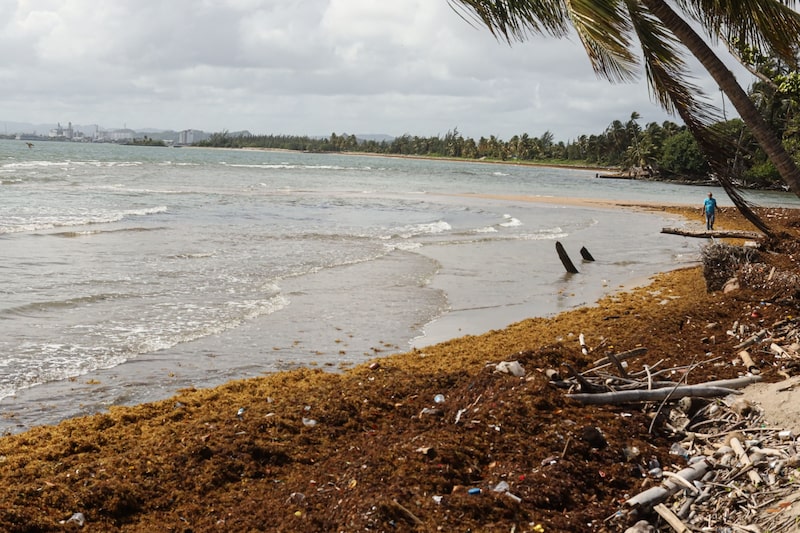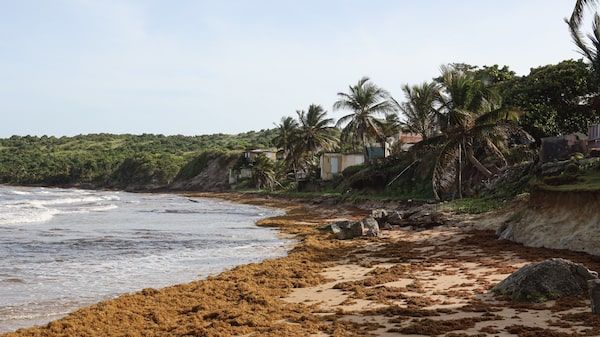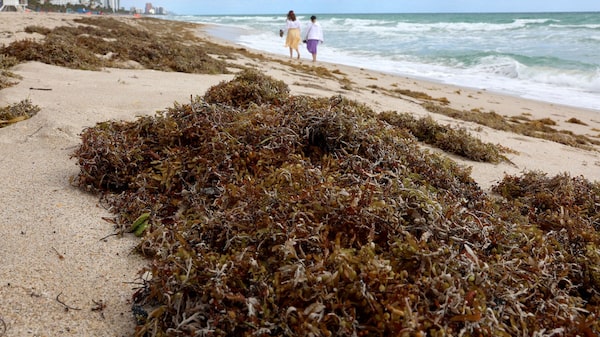Bloomberg — On the cusp of a record summer beach season in the Caribbean, Mexico and Florida, an outsized amount of sargassum seaweed is making its way toward vacationers’ favorite white sand coastlines. There’s no way to predict which destination will be hit hardest or how it might impact tourism.
This forthcoming wave isn’t a 5,000-mile, monster-sized sargassum blob, the University of South Florida’s Optical Oceanography Lab (USF) clarified in its March 2023 sargassum outlook bulletin, in light of recent news headlines. It’s simply a larger amount of clumps emerging from the 5,000-mile-wide Great Atlantic Sargassum Belt in the Atlantic. (Less than 0.1% of the water in the belt is covered by sargassum, the USF said).
Sargassum piling up on Caribbean and Florida beaches in the summertime isn’t novel, but its presence is growing in size and frequency—and 2023 is predicted to become a record year.
“The Great Atlantic Sargassum Belt was named four or five years ago, and we’ve seen the tendencies every year have been growth,” says Jake Kheel, vice president at Grupo Puntacana Foundation, a sustainable-tourism nonprofit in the Dominican Republic. “So it’s expected that from this year to the next year, there’s probably going to be more.” Grupo Puntacana’s luxury hospitality brand Puntacana Resort & Club, which includes Westin Punta Cana and Tortuga Bay, has been “messing around with barriers and collection” since 2005, Kheel adds.
Sargassum season usually runs from March until October, but major landfalls this year began in January, particularly in Mexico, Florida and parts of the Caribbean. It’s unclear how clumps within the sargassum belt have grown and whether it’s a matter of size or quantity, USF tells Bloomberg. As of March, the Great Atlantic belt, which stretches from West Africa to the Gulf of Mexico, held 13 million tons of seaweed bloom, a record for this time of year, though comparable to the most sargassum seen in 2018, according to the US National Oceanic Atmospheric Administration.
What Hotels Are Doing
“We’re watching it very closely,” says Karen Whitt, vice president of sales and marketing at Hartling Group in the Turks and Caicos Islands. “Every morning something goes out about where it is, what’s the trajectory—everyone is holding their breath on it.” In the past, the Turks and Caicos properties have had only small amounts of sargassum that are easy to clean up and remove, says Whitt.
So far, arrivals at Punta Cana Airport and stays at Puntacana Resort & Club’s hotels haven’t been affected, Kheel says. If and when the predicted record amount of sargassum hits the company’s 5 miles (8 kilometers) of white sand coastline, the plan is to continue using the same strategies, he adds.
This means installing a series of floating barriers at sea to minimize what reaches the beach and collecting the seaweed out at sea via specially equipped fishing boats that easily remove it from the ocean near shore and the barriers. Two miles of new, more efficient barriers are en route from Denmark and will be installed by mid-May, Kheel says.
Experimental projects are ongoing through the Grupo Puntacana Foundation to see if the seaweed can be turned into something useful such as biogas or forced aeration composting. The DR’s government established a working group in February to coordinate and fund a national sargassum strategy, says Kheel, adding: “We never had that before; the government wasn’t doing anything.” The working group comprises government and the private sector including the tourism industry and universities.
In Mexico, Carbonwave, a startup focused on processing fresh sargassum into plant-based products that include cosmetic emulsifiers and vegan leather, is contracting with resorts in the state of Quintana Roo to take fresh seaweed off their beaches. In 2022, its Grupo Ensol Mexico-based company collected about 12,000 tons of sargassum seaweed from Mexican beaches.
“This year we’re projecting around 30,000 tons,” says Jon Wettack, founding member and director of operations at Carbonwave. “Our current efforts are only in Mexico, but we’re looking to expand them in the future.” This would include the Caribbean region and other parts of the world, where Wettack says seaweed blooms are becoming more commonplace as humans place more nutrients in the oceans and the oceans grow warmer. (Think: the Mediterranean, India, China.)
Kheel was unable to disclose the the cost of keeping sargassum off Puntacana Resort & Club’s beaches, but says “it’s a bottomless hole.” Consider this: In 2018, cleaning up sargassum from the Caribbean’s beaches cost the region approximately $120 million.
What Travelers Can Do
Tourists are asking about sargassum more frequently, says Maurice Smith of Atlanta-based luxury agency Eugene Torikio. “Some people don’t know, so that’s where our role comes in. We have to actually educate them that during the summer months it’s a possibility, depending on where the location is, what side of the island or if it’s where there’s a natural bay.”Larger amounts this year “could definitely ruin an entire experience,” Smith adds, because the seaweed comes with a lot of debris and waste, such as plastic bottles. The agency’s vacation package includes handy travel insurance with an option to amend it to “cancel for any reason.”
Watching sargassum’s movements can prove futile, given its unpredictable nature. Monitoring social media groups, calling the hotel or asking a travel adviser about the latest conditions are your options. Smith’s agency is exploring alternative destinations or experiences that a massive sargassum influx can’t impact. “This could mean inland experiences,” he says. You might also choose resorts that have a natural barrier such as an intimate cove, or those that are quick to clean up.
If you happen to land on a day that sargassum washes ashore, there are safety precautions you can take. Seaweed sitting on a beach emits hydrogen sulfide, a toxic gas that can impact those with respiratory problems or prone to migraines. Steer clear until it’s removed; enjoy the pool or go on an excursion.
Stepping barefoot on sargassum is ill-advised because multiple organisms travel in it, including jellyfish. Swimming around it can cause skin irritations such as hives, says Wettack. Our sources agree that sargassum exposure isn’t life threatening for tourists.
For the tourism industry, it’s more than a nuisance. “It is probably our No. 1 threat right now, even more so than a hurricane,” says Whitt. “With a hurricane, it comes, it goes and you recover. With sargassum, it comes—and how long is it going to be there? It’s a really tough one.”
Read more on Bloomberg.com



